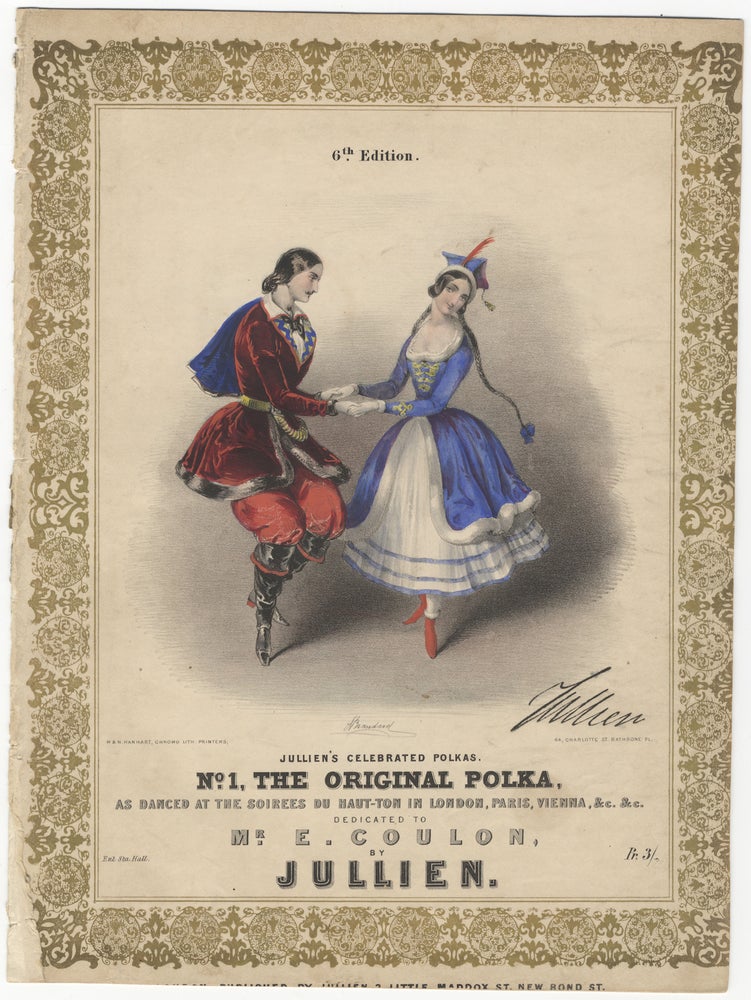
Jullien's Celebrated Polkas. No. 1, The Original Polka, as danced at the soirees du haut-ton in London, Paris, Vienna, &c. &c. Dedicated to mr. E. Coulon, by Jullien. Pr. 3/-. 6th Edition
[London]: Jullien, [ca. 1843].
Folio. Hand-coloured lithograph by J. Brandard depicting a couple in fur-trimmed costume dancing the polka, the gentleman in profile to left, the lady facing forward. Within Jullien's characteristic decorative gilt border. Signed by the artist in the stone. Printed by M. and N. Hanhart. 1f. (recto title, verso blank), [1] (description of he polka), 2-5, [i] (blank) pp. engraved music.
Disbound; slightly worn and soiled; title partially detached; trimmed, just touching border at outer edge but with loss to imprint at foot of title.
The original version of Brandard's much-adapted print referred to by Chaffee American Music Titles, 55.
"The distinguishing feature of Grisi's style as a dancer was a natural spontaneity that the public found irresistible... Her dancing always seemed effortless, but this concealed a very strong technique. Contemporary reviews make it clear that her pointe work was quite exceptionally developed for her time, and she was equal to such hazardous feats as the famous leap in La Péri. Her place in the history of ballet is also characterized by her lifelong friendship with the poet, scenarist, and critic Théophile Gautier, who conceived two of her best-known roles and who wrote several poems that owe their inspiration to her. Above all, she was the muse of the greatest choreographer of the Romantic ballet, Jules Perrot." Ivor Guest in The International Encyclopedia of Dance, Vol. 3, p. 316.
Jullien was a French composer, conductor, and music publisher. "Considered something of a child prodigy by his violinist-bandmaster father Antonio, Jullien served in the army before entering the Paris Conservatoire in 1833 or 1831. He left in 1836, preferring dance music over counterpoint. For the next three years, Jullien’s lively entertainments of dance music at the Jardin Turc brought rapid popularity, rivalling Musard’s, and three duels brought notoriety. He left Paris for England in 1838... In the democratization of music and the establishment of the early promenade concert, Jullien’s role was significant... Davison... was a supporter and personal friend: ‘M. Jullien’, he wrote in the Musical World, ‘was undoubtedly the first who directed the attention of the multitude to the classical composers … [he] broke down the barriers and let in the “crowd”.’ " Keith Horner in Grove Music Online.
John Brandard (1812-1863), an English lithographic artist, "took the chromolithograph, which had been first used in connection with music in 1841, to an incredibly high level of sophistication, using half a dozen or more stones to produce a single image, printed on paper of a far higher quality than had been used for this purpose hitherto... The colours red and blue predominate in his palette of the 1840s, along with some exquisitely diaphanous draughtsmanship and plentiful use of gold, especially in filigree borders. This latter was something Brandard may have learned when copying medieval illuminations for the Hanharts’ bound music albums. His covers convey an illusion of luxury and refinement, and are clearly aimed at the wealthier sections of society. Brandard employed two full-time assistants, allowing him to produce artwork quickly and prolifically, mainly concentrating on ballet and opera. His portraits of dancers were admired by Degas." Wikipedia.
Item #29855
Price: $175.00 other currencies
